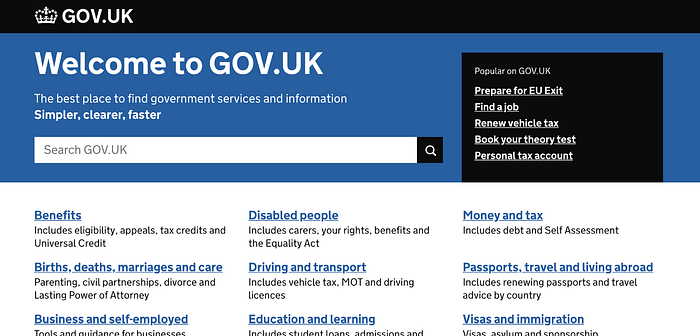First published on Medium on Sep 21, 2019
Digital user experience design is solved. All that’s left is to reap the benefits.
In 2019 experience design is something that should be implemented rather than created. Flat packed experiences, picked off the UCD shelves, bring good design to the masses. No need for creativity; just read the instructions — it’s all documented.
This is good. Really. We won!

Striking gold
Put on your rose tinted glasses…

Back in the day, brave lone design prospectors cut new paths into the digital landscape. No one knew which path was right or where it was heading. The landscape shifted as browsers evolved and devices were released. Every challenge was new, innovation was easy.
Gradually the paths became more trodden and the landscape more stable. Users recognised the patterns. Digital design struck gold. UCD, UX and analytics were refined into precious methodologies that can iterate any service to profit*. Case study after think-piece after report examined every detail, mapped every corner. We learned the ways of UX design.
Look up best practice, apply it, profit. There’s gold in them thar designs.
*Other KPIs are available.
Peak UX
Gov.uk won Design of the Year in 2013. This marks Peak UX.
It’s the designer’s anti-design. Pure brutal usability, no pixels spared; a spartan refusal to move up a user’s hierarchy of needs and create charm and interest. But what it lacks in charm it makes up for in tasks completed and services delivered. Gov.uk is a UX design triumph fully deserving of Design of the Year.

This was six years go. There are now senior UX designers who’ve had their entire career with Gov.uk as the gold standard. But what’s changed in UX since then? Where’s the new thinking?
Many sites have got a lot better by using the UX design principles and methods pioneered in that period. UX design is more widely used and accepted. Interface design patterns have been refined to their logical conclusion, maybe some minor ones have emerged. But there’s been nothing really new. Nothing new in UX design that isn’t continuation a trend underway in 2013. We’re rapidly approaching our local maximum.
(Call me out on this in the comments if I’m wrong. Voice interfaces maybe?)
The technology is stable too. Experience design possibilities are constrained by the technology users use, and the technology users use hasn’t fundamentally moved on since the iPhone. Smart watches and fitness trackers have enabled an innovation in health related services, but general purpose interface design had its last big shake up well over a decade ago.
While there hasn’t been much innovation the discipline has matured. Designing in 2019 is not the same as designing in 2013. With a lack of external innovation we turned our attention inwards. Design systems, Sketch, new tools, more new tools, plugins, how to run teams, productivity. We got really good. Professional. A well run design team in 2019 is a thing of beauty and power, pushing out design at speed that really does change things. We’ve reached another peak.
In 2013 we had solved the problem of experience design. By 2019 we solved the problem of designing at scale.
Big design implementers
UX design has shown how design makes businesses money. We’ve shown how to reproduce it at scale. That’s going to attract attention 👀
Large companies have been building in-house teams. Consultancies have been buying small agencies. And big agencies have been merging with big agencies backed by media mega-corps. By February last year Accenture, Deloitte and McKinsey spent $1.2 billion buying digital agencies. IBM has the biggest design team in the world with somewhere north of 1600 designers.
When we solved design, design became safe — so buy it and multiply! If you follow the GDS Service Manual, or your own rebranded version, you’ll end up with a adequate product. It’s hard to do excellent design and it’s hard to do crap design. Adequate design done by a competent team. Safe. Read the manual before you start. Put stickers on your laptop. Do it again. Do it with another team. Do it with ten other teams. Trial outsourcing for more scale and speed. UX design has become a set of rules — best practices — to be implemented.
Large consultancies are good at being large; they make more design more quickly for more clients. More design is a good thing. This is a thing to celebrate!
Here’s to the rise of big design implementers 🍻
What’s next?
Perhaps it’s all just the “pioneers, settlers and town planners” merry-go-round. UX design has been settled and handed over to town planners, so where do the pioneers go next? What are the new territories to map? I don’t think we can answer this yet, but there some clues:
1 — Service design. Service design has a problem with making interesting things really boring.
2 — Business design. Business design has a problem with designers bringing emoji water pistols into an artillery dual.
Both are interesting attempts at moving design up the value chain, both will need new and better tools.
3 — Design thinking. Design thinking has a hype-jargon problem, it means so much to so many people that it starts to mean nothing to anyone
—
We’re at a fork in the road. There’s a potent mix of discontent with the state of UX and new design disciplines emerging — it’s time to decide if we are pioneers or town planners.
We are starting What’s Next —a strategic design agency — to explore the next phase design. Bring on the future. We’re excited.
(We’re on twitter here if that’s your social flavour. Say hello.)